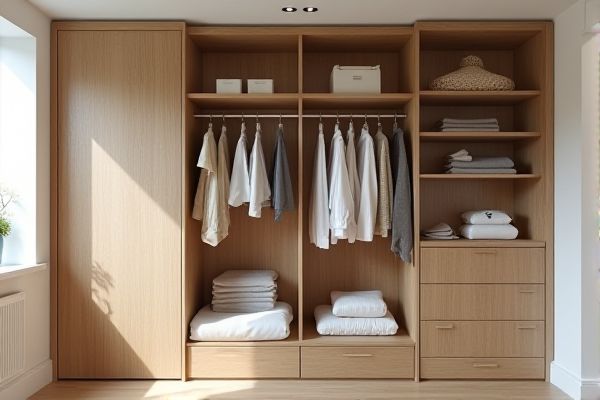
Drying cupboards provide a closed, warm environment ideal for quickly drying delicate clothes, while drying shelves offer an open, ventilated space better suited for heavier or bulkier items that require air circulation. Explore the rest of the article to discover which option best fits your laundry needs and space constraints.
Table of Comparison
| Feature | Drying Cupboard | Drying Shelves |
|---|---|---|
| Function | Enclosed space for controlled drying | Open-air drying surface |
| Drying Speed | Faster due to warm air circulation | Slower, dependent on ambient conditions |
| Capacity | Limited by cupboard size | Flexible, can be expanded with more shelves |
| Space Requirement | Takes up enclosed cabinet space | Requires wall or floor space |
| Energy Use | Uses electricity for heating and ventilation | Passive, no energy consumption |
| Best For | Delicate items needing gentle, consistent drying | Quick drying of robust items like dishes or cookware |
| Maintenance | Needs cleaning of filters and ventilation parts | Simple wipe-down cleaning |
| Cost | Higher initial and operating cost | Lower cost and minimal upkeep |
Introduction to Drying Cupboards and Drying Shelves
Drying cupboards offer a controlled environment for drying clothes, using warm air circulation to reduce moisture quickly and efficiently, making them ideal for delicate fabrics. Drying shelves provide a static drying space where garments can lie flat, helping maintain shape and prevent stretching, especially for heavy or knitted items. Your choice between the two depends on fabric type, drying speed, and care requirements to ensure optimal garment preservation.
How Drying Cupboards Work
Drying cupboards operate by circulating warm air evenly throughout enclosed compartments, accelerating the evaporation of moisture from clothes and textiles. Equipped with heating elements and ventilation systems, these cupboards maintain a controlled temperature and airflow, preventing dampness and promoting efficient drying without direct sunlight exposure. This method reduces drying time compared to traditional drying shelves, which rely solely on ambient air circulation.
How Drying Shelves Operate
Drying shelves work by allowing air to circulate freely around items placed on slatted or perforated surfaces, promoting faster evaporation of moisture. The open design helps prevent mold and mildew buildup by ensuring consistent airflow and reducing dampness. Your laundry dries efficiently without the need for heat, making drying shelves a practical and energy-saving option compared to drying cupboards.
Space Efficiency: Cupboard vs. Shelves
Drying cupboards maximize space efficiency by providing enclosed storage that protects items from dust and allows vertical stacking, making them ideal for small or cluttered areas. Drying shelves offer more open space but require larger wall or floor areas, which can limit their usability in compact rooms. Your choice depends on balancing enclosed, space-saving storage with the need for accessible, airy drying solutions.
Energy Consumption Comparison
Drying cupboards typically consume more energy than drying shelves due to their enclosed design and integrated heating elements that accelerate drying times. Drying shelves rely primarily on natural airflow and ambient temperatures, resulting in significantly lower energy usage or even zero consumption when no artificial heat is applied. Energy consumption for drying cupboards can range from 0.5 to 1.5 kWh per drying cycle, while drying shelves operate efficiently without added electrical power, making them a more eco-friendly option.
Drying Speed and Performance
Drying cupboards provide faster drying speeds by enclosing clothes in a warm, ventilated space that accelerates moisture evaporation, making them ideal for quick laundry turnover. Drying shelves offer slower, natural air drying but are gentler on delicate fabrics, preserving garment quality over time. For optimal drying performance, your choice depends on balancing speed requirements with fabric care needs.
Material and Fabric Compatibility
Drying cupboards offer a controlled, enclosed environment ideal for delicate fabrics like silk, wool, and synthetics, preventing exposure to dust and maintaining gentle airflow to avoid damage. Drying shelves, typically made of wood or metal, provide open-air drying suitable for heavier fabrics such as denim and cotton, but may risk uneven drying and potential fabric stiffness. Choose drying cupboards for sensitive garments requiring consistent, low-heat conditions, while shelves suit everyday items that tolerate natural airflow and slight texture changes.
Installation and Maintenance Requirements
Drying cupboards require professional installation due to built-in ventilation and electrical components, whereas drying shelves are simpler to install and often just need a sturdy frame or wall mounts. Maintenance for drying cupboards involves regular cleaning of filters and checking electrical parts, while drying shelves need occasional dusting and inspections for structural integrity. Your choice depends on whether you prefer a high-maintenance, efficient drying system or a low-maintenance, flexible option.
Cost Analysis: Upfront and Long-Term
Drying cupboards generally require a higher upfront investment compared to drying shelves due to their enclosed design and integrated heating elements. Over the long term, drying cupboards offer energy efficiency by maintaining consistent drying temperatures, potentially reducing operational costs, whereas drying shelves have lower initial costs but may result in longer drying times and higher energy use. You should weigh the balance between initial expenditure and ongoing energy expenses to determine the most cost-effective drying solution for your needs.
Choosing the Right Option for Your Needs
Drying cupboards offer enclosed, warm environments ideal for delicate fabrics requiring gentle drying, preventing dust and contaminants from settling on clothes. Drying shelves provide open-air circulation suitable for heavier textiles and rapid drying, making them more energy-efficient and space-saving. Selecting between these options depends on fabric types, available space, and drying speed preferences to optimize garment care and convenience.
 homyna.com
homyna.com